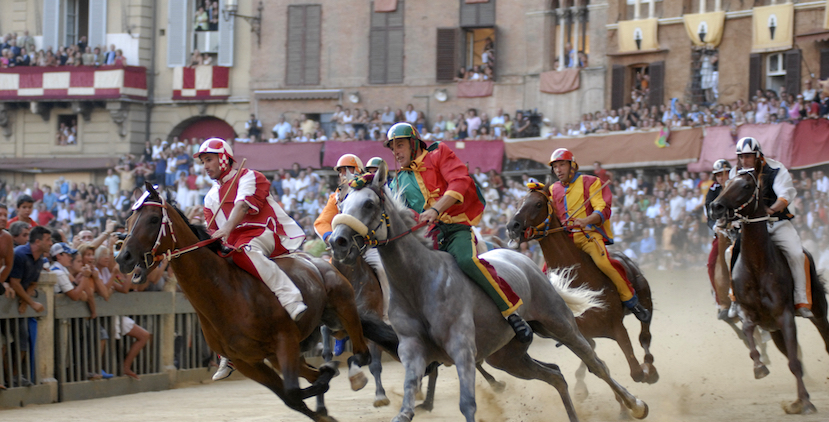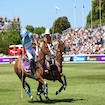
Silence envelops the crowd until the rope drops and deafening applause floods the cobbled streets of Siena. Ten horses and their jockeys burst from the starting line at the sound of a firecracker and charge onto the makeshift track, stirring up dust and fierce rivalries between supporters in the stands. All eyes follow the competitors; horses jostle under a blistering sun, competing for a chance to carry their contrada to victory. It’s no surprise that many are drawn to wager on horses where tradition meets raw excitement. This is one of the greatest horse races in Italy. This is the Palio di Siena.

The Palio di Siena is the oldest horse race in the world, dating back an estimated 800 years. It is a cornerstone of the Italian horse racing calendar, held annually on the 2nd of July and the 16th of August. Siena is a UNESCO-listed medieval town in Tuscany and is best known for this lawless race that draws more than 40,000 enthusiastic fans each year. Ten jockeys and their equine partners, each representing a city district, go head-to-head for a fleeting 90 seconds in an electrifying three-lap race around the city’s central Piazza del Campo. The prize? A hand-painted silk banner called a palio.

The race is preceded by three days of rituals and celebrations. These include parades, music performances, religious ceremonies, and, of course horse track betting. The night before the Palio, the contrade and their followers gather under the stars in the piazza for a friendly meal before the chaos begins. Long banquet tables stretch past the ancient red brick buildings and local volunteers cook traditional dishes that are accompanied by ever-flowing wine and lively discussion of the coming race. A few members break into song and soon everyone is singing in passionate support of their own contrada. Only one will succeed tomorrow.

Siena’s central square, the Piazza del Campo, is transformed beyond recognition in the days leading up to the race. A gritty mixture of clay and earth is packed onto the golden cobbles, creating a compact and level track for the horses and protecting the ancient tiles beneath. Where lively restaurants and cafés usually spill out into the square like leaves from a vine, bleachers are assembled for the thousands of fans and barriers are erected to mark the perimeter of the circuit. Even though there are 17 city districts, the limited space on the piazza’s track means that only ten can be represented each year. The remaining seven will be automatically entered the following year and the other three are decided by ballot.

In front of the packed, jostling crowd standing in the centre of the square, nine impatient horses line up behind a starting rope, with one slightly behind. Once this horse starts running and levels with its rivals, the rope is dropped, and the race begins. What follows is a minute and a half of ruthless battle. Each jockey has a whip to encourage their horse – although these are often used to lash fellow riders – and is kitted out in the colours of their district to help the audience follow them in the blur of hooves and stripes.
The winning horse crosses the finish line and chaos ensues. Members of the victorious contrada flood into Siena’s magnificent cathedral to receive their palio, leaving behind the inevitable anguish and disappointment of the losers. Banners and flags bearing the symbol of the victor are hoisted in the air as deafening chants envelop the city.
Siena is made up of 17 contrade, or neighbourhoods, all named after either an animal or a natural symbol. These include Dragon, Shell, Owl and Ram and together they have a long and fiery history of competition and even sabotage. Many contrade even have individual rivalries such as the long-standing contention between Eagle and Panther.
 These identities were established in the Middle Ages and were originally associated with military conscription when Siena’s independence was under threat from nearby Florence. However, over the years these communities have departed from their defensive roots to become coteries bound by a collective history and local patriotism. Each contrada has its own insignia, public holiday, museum and motto. On the day of the Palio, the square brims with a kaleidoscopic sea of flags and banners; there is an unrivalled sense of pride associated with donning the colours of your community on race day.
These identities were established in the Middle Ages and were originally associated with military conscription when Siena’s independence was under threat from nearby Florence. However, over the years these communities have departed from their defensive roots to become coteries bound by a collective history and local patriotism. Each contrada has its own insignia, public holiday, museum and motto. On the day of the Palio, the square brims with a kaleidoscopic sea of flags and banners; there is an unrivalled sense of pride associated with donning the colours of your community on race day.
A free ticket into the Piazza del Campo will place you in the midst of the action of one of the most eagerly-anticipated horse races in Italy. However, plenty of options are available where you can watch the race play out in comfortable seating accompanied by a glass of champagne or fine Tuscan wine. The balconies that extend from the charming buildings surrounding the square offer an ideal vantage point for race day; you’ll be hard-pushed to find a better view. A few offer prime front-row seats above the mossa where riders begin with exhilaration and – save for one – cross the line in despairing defeat. Luxury packages are available and include this fine example of Italian horse racing, accommodation, private tours of the city, and even five-star meals.

For enthusiasts of horse racing, history and refinement alike, the Palio di Siena is an unparalleled experience. It is a unique chance to immerse yourself in the city’s long-standing local traditions and to do so in luxury. Attend the Palio to experience the action first-hand and become a part of history.

